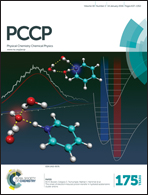Interfacial electronic structure and charge transfer of hybrid graphene quantum dot and graphitic carbon nitride nanocomposites: insights into high efficiency for photocatalytic solar water splitting
Abstract
New metal-free carbon nanodot/carbon nitride (C3N4) nanocomposites have shown to exhibit high efficiency for photocatalytic solar water splitting. (J. Liu, et al., Science, 2015, 347, 970) However, the mechanism underlying the ultrahigh performance of these nanocomposites and consequently the possibilities for further improvements are not at present clear. In this work, we performed hybrid functional calculations and included long-range dispersion corrections to accurately characterize the interfacial electron coupling of the graphene quantum dot–graphitic carbon nitride composites (Gdot/g-C3N4). The results revealed that the band gap of Gdot/g-C3N4 could be engineered by changing the lateral size of Gdots. In particular, the C24H12/g-C3N4 composites present an ideal band gap of 1.92 eV to harvest a large part of solar light. More interestingly, a type-II heterojunction is formed at the interface of the Gdot/g-C3N4 composites, a desirable feature for enhanced photocatalytic activity. The charge redistribution at the interface leads to strong electron depletion above the Gdot sheet and electron accumulation below the g-C3N4 monolayer, potentially facilitating the separation of H2O oxidation and reduction reactions. Furthermore, we suggested that the photocatalytic performance of the Gdot/g-C3N4 nanocomposites can be further improved by decreasing the thickness of Gdots and tuning the size of Gdots.


 Please wait while we load your content...
Please wait while we load your content...